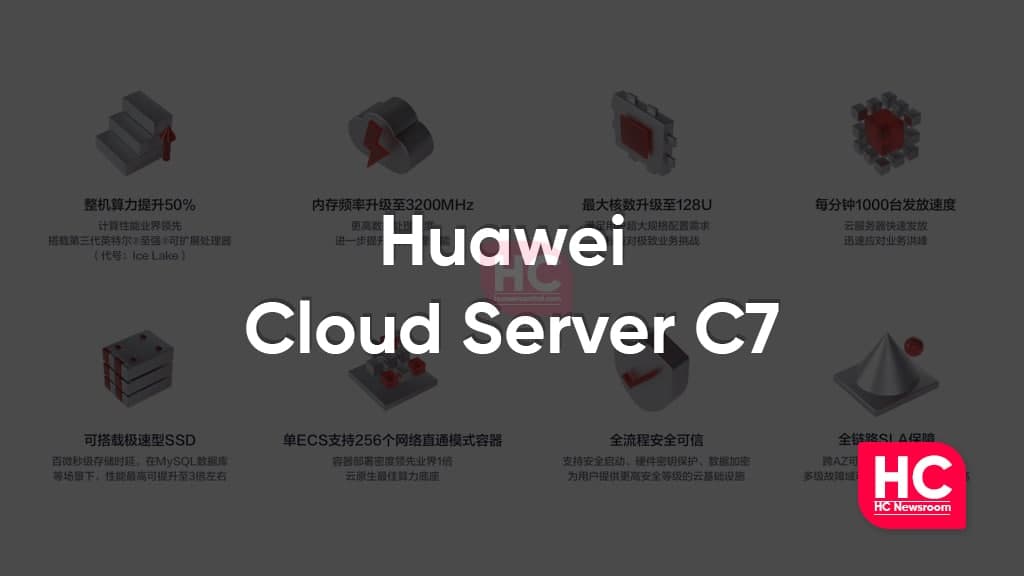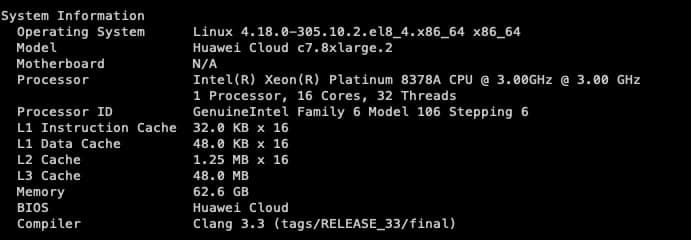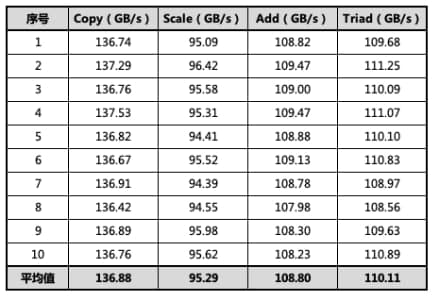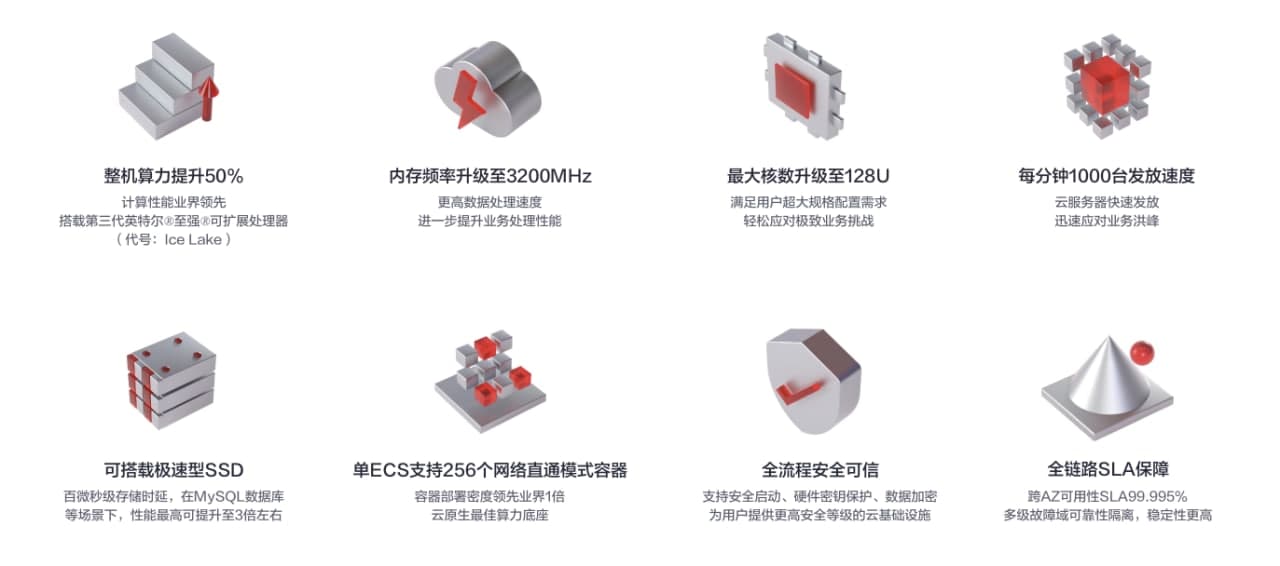News
Huawei flagship Cloud Server C7 officially opened for commercial use

Huawei has finally launched the new generation flagship cloud server C7 for commercial use. The C7 cloud server comes with the support of Huawei Cloud’s DynaSky architecture to provide additional benefits and is powered by a third-generation Intel Xeon scalable processor (Code: Ice Lake).
With the usage of this, the overall computing performance has been improved by 50% compared to previous cloud servers. In today’s era of the digital economy, computing power is a basic resource. Its improvements have a huge impact on the improvement of the entire business capability.
Nowadays, several Internet or hardware manufacturers are selling their own cloud servers. In essence, they are also stable and reliable solutions that are slowly formed from their own business needs. These cloud server products cover the daily operations and various scene requirements of enterprises.
Huawei Cloud Server C7:
Huawei flagship Cloud Server C7 is initially a product from Huawei Cloud General Computing Enhanced Cloud Server. It delivers excellent performance and ultra-high stability and is now officially commercialized.

General-purpose computing enhanced cloud server C7:
1. Platform introduction
HUAWEI CLOUD C7 is equipped with the third-generation Intel® Xeon® Scalable processor with a base frequency of 3.0GHz and a turbo frequency of 3.5GHz. Provides server configuration options with two core memory ratios of 1:2 and 1:4.
Among them, the processor can choose from 2 to 128 cores, and the memory can be selected from 4 to 512GB. There are a total of 22 models to choose from. The maximum packet sending and receiving capacity can reach 12 million PPS in one direction, and the maximum intranet bandwidth can reach 40Gbps.
Compared with the previous Huawei Cloud C6 and C3 products, the maximum number of processor cores and memory numbers supported by the Cloud C7 have been greatly improved this time based on the second-generation Intel Xeon Scalable processor. The maximum number of cores of Huawei Cloud C6 is 64 cores and the maximum memory is 256GB.

Memory configuration in Huawei Cloud C7 has been upgraded to 8-channel, 3200MHz based on the original 6-channel, 2933MHz, and the efficiency of the program access to memory is greatly improved.
Huawei Cloud C7 is more suitable for heavy load, computing and network requirements are very high application scenarios, such as large e-commerce platforms, online games, short videos, insurance finance, and other business scenarios. These scenarios often exist sudden large-flow, high-frequency, and heavy-load operations that have a very high response speed to cloud servers.
2. Processor and memory performance
Huawei Cloud C7 uses a 16-core 32-thread design, corresponding to a 48MB L3 cache. To see Huawei Cloud C7 processor performance it was tested ob Geekbench 3 and the results are as follow:

Huawei Cloud C7 (32U64G) single-core integer score is 5011 points, single-core floating point score is 4397 points, multi-core integer score is 91386 points, and multi-core floating point score is 91063 points. It has powerful turbo frequency capability, provides very strong performance, and its single-core performance has been greatly improved.

The stream memory test tool was used to conduct a special test on the memory performance of Huawei Cloud C7 that supports four operations of memory Copy, Scale, Add, and Triad. The memory performance of Huawei Cloud C7 through 10 consecutive tests. The test compiled code is as follows:

The test results show that it has a very powerful memory ratio performance. Its Copy operation performance is close to 138GB/s, Scale operation performance is around 95GB/s, and Add and Triad operating systems can be around 1100GB/s.
3. Intranet performance
The intranet bandwidth receiving capability of Huawei Cloud C7 through netperf. According to the data from the official website of Huawei Cloud, the maximum internal network bandwidth of Huawei Cloud C7 can reach 42Gbps, and the 32-core 64GB specification that IT House selects has a maximum internal network bandwidth of 30Gbps. The running password of the test device and results is as follows:
The result discloses that the average intranet bandwidth under the test of Huawei Cloud C7 basically ran up to 30Gbps of intranet bandwidth. The powerful intranet bandwidth can carry out greater data exchange per unit of time. In order to achieve greater data processing capabilities.
Next, we use the iperf tool to test the ability of Huawei Cloud C7 intranet to send and receive packets. Intranet is an important indicator to measure the performance of the cloud server’s intranet. This indicator refers to the number of packets sent per second on the intranet. , Here we still use four sparring machines for streaming, and the running password of the test machine is as follows:
Through the test, we have seen that the one-way PPS reception of Huawei Cloud C7 is about 5.5 million PPS, which is a very good level. The powerful intranet packet sending and receiving capabilities can efficiently respond to the data transmission needs of heavy-load applications.
Fourth, the scene test
A good server not only pays attention to performance indicators but also the performance of real scenes is particularly important for the balance of the advantages and disadvantages of the server. To test here uses FFmpeg transcoding, memcached object caching tool, redis dictionary service The tool, HTTP stress testing tool wrk, conducts scenario-based testing on HUAWEI CLOUD C7.
FFmpeg
It is an open source audio and video codec tool, FFmpeg is sought after by many users. Its strong video capture, format conversion, video capture, and watermarking capabilities are also loved by many people. The test od Huawei Cloud C7 (32U64G) to re-encode the 2GB video file, and the results are as follows:
Huawei Cloud C7 (32U64G) took 4 minutes and 49 seconds to transcode a 2GB video file, and the video processing speed of a total of 62,052 frames reached 214 frames per second. With the powerful computing power of HUAWEI CLOUD C7, video transcoding time is also greatly compressed.
Redis
Redis comes with its own performance testing tool. Here, it is used the Redis-benchmark tool to test through two Huawei Cloud C7s (32U64G) with the same configuration. The use of 1,000,000 data processing to detect the performance of Redis’s SET, GET, SADD, and MSET operations. The client test password is as follows:
The powerful memory performance and computing power of Huawei Cloud C7 have brought strong performance support to the Redis service, with a data processing capacity of 155,000 times per second.
Among them, more than 99% of SET operations are completed within 0.7 milliseconds, and more than 99% of GET, SADD, and MSET operations are completed within 1 millisecond. The huge data processing capabilities allow us to see the powerful computing power and high-speed support of the Huawei Cloud C7 Memory guarantee.
Memcached
Memcached is a distributed cache system. As compared with redis, memcached stores all data in memory and will be lost when power is off. Therefore, it cannot achieve persistence support. In addition, memcached supports fewer data types.
However, memcached also supports caching other media files, such as pictures and videos. For the transmission of some small files and low-bandwidth scenarios, memcached is obviously more suitable. In order to make more effective use of memory resources, memcached will use distributed memory object caching technology for memory expansion to obtain more memory resources.
Memcached comes with a memaslap stress test tool to test the cache performance between servers. Here, 3 sets of the same specifications of Huawei Cloud C7 (32U64G) to test the cache performance between servers, one of which is a test the other two are client computers. The test device turns on a total of 16 ports from 11210 to 11226 for testing, and two clients perform stress tests on 8 ports respectively.
Result: In the 60-second test time, the total number of operations on the two clients exceeded 230 million, and the maximum number of operations per second of the test machine can exceed 3.8 million TPS, which highlights the powerful processing capabilities of the distributed memory object cache.

wrk+nginx
nginx is a powerful HTTP and reverses proxy web server. It also supports email proxy services, load balancing, and other functions. It is a very popular open-source server product at this stage. Its features of low memory footprint and strong concurrency have been favored by many domestic Internet giants.
The HTTP server is also the type of server that we are most likely to come into contact with. After all, many of our Internet browsing needs are through HTTP servers, such as the rush to purchase goods on Double 11, and the 12306 Spring Festival ticket purchase. Can you resist it? The pressure brought by large-scale traffic over a period of time is also an important criterion for measuring HTTP servers. wrk is a simple HTTP stress testing tool, it can use a few threads to achieve a very large amount of concurrency.
Two Huawei Cloud C7 (32U64G) servers to deploy nginx and wrk, where nginx is deployed as a test machine, and wrk is deployed as a client. Generally speaking, wrk stress test threads should not be too many, 2-4 times the number of cores. Here, 20,000 connections and 64 threads were choosen for testing. The test time is 120 seconds.
The test results reveals that Huawei Cloud C7 (32U64G) has processed 150 million requests within 2 minutes under the condition of nginx long link, and the average delay of each thread is 23.06 milliseconds. On the whole, a single server has an average of Nearly 1.3 million requests are processed in seconds.
After concluding the four scene-based tests of ffmpeg, redis, memcached, and wrk+nginx, it is observed that the outstanding performance of Huawei Cloud C7 in terms of processor, memory, network performance, and storage is largely due to new hardware upgrades.
Meanwhile, the theoretical tests and actual application scenarios clearly feel the consistency between the theory and reality of the Huawei Cloud C7 server.
Additional details:
The development of the Huawei HarmonyOS ecosystem and the infrastructure of Huawei Cloud can fully cover the entire scene of the C-side and B-side. Currently, Huawei Cloud C7 products are open for purchase, and joining now may bring a better and more stable application experience for future business needs.
(Source)






